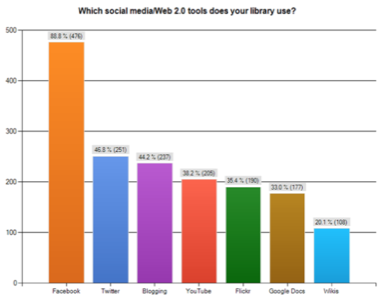
Like many of you, I’m connected to the Internet virtually every waking hour of my day – via computer, tablet and mobile phone. Yet I still regularly visit my local public library, in order to borrow books, CDs and DVDs. Which made me wonder: are these two worlds disconnected, or is the Social Web being integrated into our public libraries? In this fourth installment in ReadWriteWeb’s Social Books series, I aim to find out!
The American Library Association (ALA) released a report earlier this year entitled The 2012 State of America’s Libraries. The report states that “Facebook and Twitter in particular have proven themselves useful tools not only in publicizing the availability of online collections, but also in building trusted relationships with users.”
According to a survey conducted by the South Carolina State Library, 88% of respondents (all library workers) claimed to use Facebook in their work. Twitter was second most popular, at 46.8%.

So what are libraries using Facebook for and what does “building trusted relationships with users” mean? The ALA report elaborated:
“Social networking is used to publicize library events such as gaming nights; to alert users to additions to collections; to provide links to articles, videos, or Web content that might prove relevant or helpful to patrons; and to provide a conduit for community information. Social media also play an important role in fostering relationships with the community by allowing patrons to ask questions or provide feedback about library services.”
This is precisely how my own local library, Wellington Library, uses Facebook. It’s on a raft of other social media platforms too – including Twitter, YouTube and Flickr. Wellington Library even updates its Facebook page using IFTTT, a syndication service beloved by Web geeks.

Enhanced Catalogs & Mobile Apps
But there’s more that libraries can do to create a social experience for their patrons, other than being active on Facebook. LibraryThing for Libraries is a set of services offered by the company LibraryThing. It features catalog enhancements (such as user-generated book reviews and recommendations) and a customizable mobile app called Library Anywhere.

In June, LibraryThing for Libraries had 800,000 “professionally vetted reviews.” While library users could just go and get reviews and recommendations from Amazon or Goodreads, it does seem useful to have them integrated into a library’s catalog.
In a discussion in Branch, Portland librarian Justin Hoenke called LibraryThing “the ultimate social reading tool for libraries.” Although Sarah Houghton, Director of the San Rafael Public Library in California, cast some doubt on whether library patrons use the reviews regularly.
Reimagining The Library Book
Some libraries are experimenting not just with socializing the library catalog, but the reading process itself. New York Public Library has released an interactive website called Candide 2.0, a community annotated version of Voltaire’s 1759 book called Candide. The NYPL version is described as an “experiment in public reading and communal annotation.”

It’ll be fascinating to track how libraries continue to bring the Social Web to their organizations. I haven’t even touched on the increasing prevalence of e-books inside libraries – another trend that potentially creates a more social experience for library patrons (for example, with social book highlights).
How about you, do you still go to your local library? If so, I’d love to hear your thoughts on how Web technologies are being deployed by your public library.










